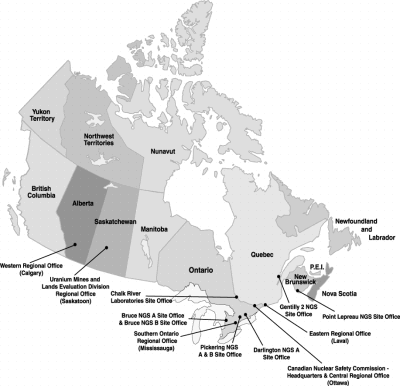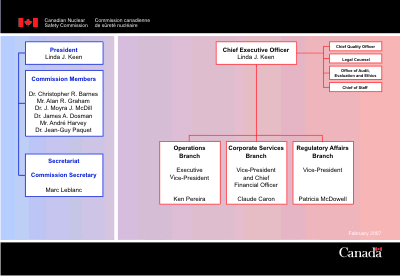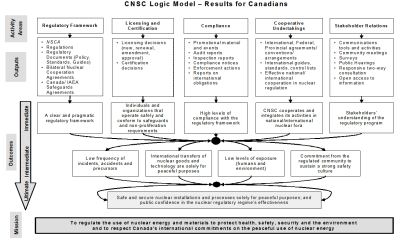Common menu bar links
Breadcrumb Trail
ARCHIVED - RPP 2007-2008
Canadian Nuclear Safety Commission
 This page has been archived.
This page has been archived.
Archived Content
Information identified as archived on the Web is for reference, research or recordkeeping purposes. It has not been altered or updated after the date of archiving. Web pages that are archived on the Web are not subject to the Government of Canada Web Standards. As per the Communications Policy of the Government of Canada, you can request alternate formats on the "Contact Us" page.
SECTION III - SUPPLEMENTARY INFORMATION
Organizational Information
The CNSC consists of two independent organizations:
(i) Commission
The Commission, supported by the Secretariat, is a quasi-judicial administrative tribunal. It sets regulatory policy direction on matters relating to health, safety, security and environmental issues affecting the Canadian nuclear industry; makes independent decisions on the licensing of nuclear-related activities in Canada; and establishes legally-binding regulations. The Commission takes into account the views, concerns and opinions of interested stakeholders. The Commission also delegates to Designated Officers the authority to render licensing decisions for certain categories of nuclear facilities and activities in accordance with the requirements of the Nuclear Safety and Control Act (NSCA) and its associated regulations.
The NSCA provides for the appointment of up to seven Commission members by the Governor in Council serving at good behaviour. Six members serve as permanent members for a term not exceeding five years. One member of the Commission is designated as the President of the Commission. This position is currently held by Linda J. Keen.
(ii) CNSC Staff
The staff organization consists of a headquarters in Ottawa, site offices located at each of the five nuclear generating stations in Canada, a site office at Atomic Energy of Canada's Chalk River Laboratories and five regional offices. CNSC staff is permanently located at each nuclear generating station in Canada and at Chalk River to assess performance against regulations and specific conditions of operating licences. Regional offices conduct compliance activities for nuclear substances, transportation, radiation devices and equipment containing nuclear substances. They also respond to unusual events involving nuclear substances.
CNSC staff supports the Commission by developing regulatory frameworks and recommending regulatory policies, carrying out licensing, certification, compliance inspections and enforcement actions, coordinating the CNSC's international undertakings, developing CNSC-wide programs in support of regulatory effectiveness, maintaining relations with stakeholders and providing administrative support to the organization.
In addition, staff prepares recommendations on licensing decisions, presents them to the Commission for consideration during public hearings and subsequently administers the Commission's decisions. Where authority has been delegated, staff renders licensing decisions.
CNSC Locations

CNSC Organization Chart
The CNSC Logic Model
The logic model is a tool for planning, focusing activities and programs, evaluating the contribution of initiatives to CNSC outcomes, and illustrating the role of the CNSC as an agency in terms of achieving results for Canadians.
Resources by Program Activity
|
2007-2008 |
|||||||||||
|
Budgetary |
Non-budgetary |
Total Main Estimates |
Adjustments (Planned Spending not in Main Estimates) |
Total Planned Spending |
|||||||
|
Operating |
Capital |
Grants |
Contributions and Other Transfer Payments |
Gross Budgetary Expenditures |
Less: Respendable Revenue |
Net Budgetary Expenditures |
Loans, Investments and Advances |
||||
|
Strategic Outcome: Safe and secure nuclear installations and processes solely for peaceful purposes; and public confidence in the nuclear regulatory regime's effectiveness. |
|||||||||||
|
Nuclear Regulation |
94,065 |
0 |
75 |
345 |
94,485 |
0 |
94,485 |
0 |
94,485 |
70 |
94,555 |
|
Total |
94,065 |
0 |
75 |
345 |
94,485 |
0 |
94,485 |
0 |
94,485 |
70 |
94,555 |
The program activity contributes to the achievement of the Government of Canada's Safe and Secure Communities outcome area
Table 1: Departmental Planned Spending and Full-Time Equivalents
|
$ thousands |
Forecast Spending 2006-2007 |
Planned Spending 2007-2008 |
Planned Spending 2008-2009 |
Planned Spending 2009-2010 |
|
Nuclear Regulation |
78,671 |
94,485 |
85,876 |
85,876 |
|
Total Main Estimates |
78,671 |
94,485 |
85,876 |
85,876 |
|
Adjustments: |
||||
|
Procurement Savings |
(390) |
- |
- |
- |
|
Supplementary Estimates: |
- |
- |
- |
|
|
Advanced CANDU Reactors |
1,448 |
- |
- |
- |
|
Carry Forward |
2,545 |
- |
- |
- |
|
Workload Pressures |
1,159 |
- |
- |
- |
|
New Nuclear Power plants |
1,308 |
- |
- |
- |
|
Other: |
- |
- |
- |
|
|
TB Vote 15 |
602 |
- |
- |
- |
|
Internal Audit Funding |
54 |
70 |
- |
- |
|
Employee Benefit Plan (EBP) |
715 |
- |
- |
- |
|
Total Adjustments |
7,441 |
70 |
- |
- |
|
Total Planned Spending |
86,112 |
94,555 |
85,876 |
85,876 |
|
Total Planned Spending |
86,112 |
94,555 |
85,876 |
85,876 |
|
Less: Non-Respendable Revenue |
57,783 |
61,415 |
56,208 |
56,208 |
|
Plus: Cost of services received without charge |
8,835 |
9,712 |
9,127 |
9,131 |
|
Net cost of Program |
37,164 |
42,852 |
38,795 |
38,799 |
|
Full Time Equivalents |
585 |
730 |
693 |
693 |
The above table includes funding approved for 2006-2007 and 2007-2008 for the regulatory workload associated with licensing new nuclear power plants.
Table 2: Voted and Statutory Items
|
Vote or Statutory Item |
Truncated Vote or Statutory Wording |
2007-2008 Main Estimates |
2006-2007 Main Estimates |
|
20 |
Program expenditures |
84 553 |
70 321 |
|
(S) |
Contributions to employee benefit plans |
9,932 |
8,350 |
|
Total Department or Agency |
94,485 |
78,671 |
|
Note: The 2007-2008 Main Estimates are $15,814 thousand greater than the 2006-2007 Main Estimates. The major changes are associated with the approval of $9.2 million to meet existing demand and forecasted increase in regulatory workload associated with industry growth; $4.9 million to meet new demand in regulatory workload associated with licensing new nuclear power plants; and approximately $1.5 million for statutory Employee Benefits Plan.
Table 3: Services Received Without Charge
|
($ thousands) |
2007-2008 |
|
Accommodation provided by Public Works and Government Services Canada |
5,518 |
|
Contributions covering the employers' share of employees' insurance premiums and expenditures paid by the Treasury Board of Canada Secretariat (excluding revolving funds) Employer's contribution to employees' insured benefits plans and expenditures paid by TBS |
4,026 |
|
Salary and associated expenditures of legal services provided by the Department of Justice Canada |
91 |
|
Audit Services provided by the Office of the Auditor General of Canada |
65 |
|
Worker's compensation coverage provided by Social Development Canada |
12 |
|
Total 2007-2008 Services received without charge |
9,712 |
Table 4: Sources of Respendable and Non-Respendable Revenue
|
Respendable Revenue |
||||
|
($ thousands) |
Forecast Revenue 2006-2007 |
Planned Revenue 2007-2008 |
Planned Revenue 2008-2009 |
Planned Revenue 2009-2010 |
|
Total Respendable Revenue |
0 |
0 |
0 |
0 |
|
Non-Respendable Revenue |
||||
|
($ thousands) |
Forecast Revenue 2006-2007 |
Planned Revenue 2007-2008 |
Planned Revenue 2008-2009 |
Planned Revenue 2009-2010 |
|
Nuclear Regulation |
||||
|
Cost Recovery Revenue |
57,783 |
61,415 |
56,208 |
56,208 |
|
Total Non-Respendable Revenue |
57,783 |
61,415 |
56,208 |
56,208 |
|
Total Respendable and Non-Respendable Revenue |
57,783 |
61,415 |
56,208 |
56,208 |
Table 5: CNSC's Regulatory Plan
The preparation of regulations pursuant to the Nuclear Safety and Control Act is necessary to provide clarity and enforcement. The CNSC expects to submit the following specific regulations for legal examination or final approval over the three-year planning period:
|
Regulations |
Expected Results |
|
Nuclear Substances and Radiation Devices Regulations - Amendment |
|
|
Class II Nuclear Facilities and Prescribed Equipment Regulations - Amendment |
|
|
Nuclear Safeguards Regulations |
|
|
Nuclear Non-proliferation Import and Export Control Regulations - Amendment |
|
|
Canadian Nuclear Safety Commission Rules of Procedure and Canadian Nuclear Safety Commission By-laws |
|
Table 6: Internal Audits and Evaluations
Planned Internal Audits and Evaluations (2007-08 to 2009-10)
In 2005, the CNSC developed a risk-informed internal audit and evaluation work plan, which it shared with the Treasury Board of Canada Secretariat. The plan which was revised in 2006, is being revisited in the context of a CNSC Corporate Risk Profile that will be developed early in 2007-08. The following plan may therefore be revised.
For more information on CNSC's Internal Audit and Evaluation Reports and Summaries visit CNSC's website
|
Name of Internal Audit/Evaluation |
Audit Type/Evaluation Type |
Status |
Expected Completion Date |
|
Audit of the CNSC's regulatory program for uranium mines and mills |
Organizational unit |
In progress |
April 2007 |
|
Formative evaluation of the Values and Ethics Strategy |
CNSC program |
In planning stage |
August 2007 |
|
Audit of operational planning (including integrated risk management) |
Corporate-wide initiative |
Planned |
2007-08 |
|
Audit of time accounting |
Corporate service |
Planned |
2007-08 |
|
Evaluation of the CNSC Outreach Program |
CNSC program |
Planned |
2007-08 |
|
Audit of nuclear substances regulation and medical institutions |
Organizational unit |
Planned |
2008-09 |
|
Audit of information management |
Corporate service |
Planned |
2008-09 |
|
Audit of the Contaminated Lands Evaluation and Assessment Network |
Program |
Planned |
2008-09 |
|
Evaluation of Research and Support Program grants and contributions |
Transfer payment |
Planned |
2008-09 |
|
Audit of power reactor regulation |
Organizational unit |
Planned |
2009-10 |
|
Audit of international activities - monitoring and coordination |
CNSC program |
Planned |
2009-10 |
|
Evaluation of IAEA-CNSC Contribution Agreement for Canadian Safeguards Support Program |
Transfer payment |
Planned |
2009-10 |
Information Sources
For further information or to request publications, contact:
Canadian Nuclear Safety Commission
280 Slater Street, P.O. Box 1046, Station B
Ottawa, Ontario K1P 5S9
Telephone: (613) 995-5894 or 1-800-668-5284 (within Canada) Fax: (613) 995-5086
e-mail: info@ccsn-ccsn.gc.ca
Further information is available on the CNSC Web site at www.nuclearsafety.gc.ca
Information on the plans, priorities, and activities of the CNSC may be found in:
Annual Report, Canadian Nuclear Safety
Commission
Report on Plans and Priorities, Canadian
Nuclear Safety Commission
Departmental Performance Report, Canadian
Nuclear Safety Commission
The CNSC administers the following Acts and associated regulations:
Nuclear Safety and Control Act, 1997, c.9
Nuclear Liability Act, 1985, c. N-28


